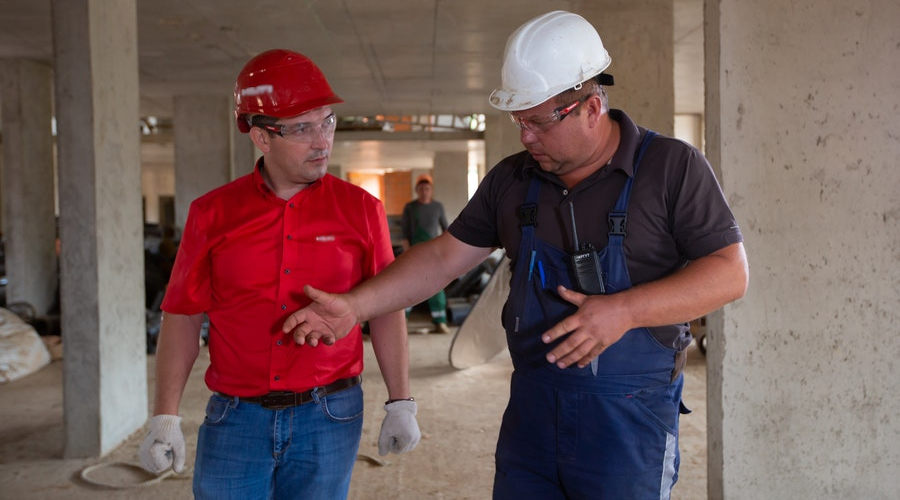Project management in construction requires very clear and concise communication. If something goes wrong, there could be dire consequences that could slow a project down, or even cause injury or death.
Construction is a truly global business. It is also a sector that uses very specific terminology. This includes language that wouldn’t necessarily be used in everyday communication. Developing a glossary of key terms could be vital in the first steps of providing translation.

Communication is critical, especially with construction project management.
The Mobile Workforce
The way we have organized our global economy means that we have promoted a multilingual working life. This is due to increased work migration and mobility.
In the Baltic Sea region of Europe, many people will travel to Germany and Scandinavia. This is because of the wages on offer, the demand for services, and the possibilities of finding work. A building site in Sweden is likely to have carpenters, kitchen installers, and ground workers from Ukraine, Poland, and Estonia.
In the United States, there are just over 10 million workers in construction. More than 3 million of them are Hispanic. This is close to one-third of the total workforce.

The construction industry has an incredibly diverse workforce. This holds true almost everywhere in the world.
Breaking Down Barriers
As somebody who comes from the UK and has lived in many different countries, including Thailand, Mexico, and Spain, I understand how difficult it can be to assimilate a new culture and try to learn the language.
In S.E. Asia, for example, there is a strong culture of “saving face.” To have public disagreements or conflicts is seen to be extremely embarrassing. This means that you have to be very careful when confronting an issue. Often communication will be very indirect. If you go against this cultural norm, you risk causing a lot of tension and offense.
Top Quality Construction Translation Services
Request a quote for translation of construction documents today.
Get a Free Quote
As a Westerner, who is used to speaking my mind, this was initially very frustrating. However, learning to integrate and appreciate different cultural norms is essential if you want to succeed at work, and in life. I had to realize that my own way of communicating was entirely a cultural construct and that it has its own drawbacks.
Utilizing Technology
In the modern day, technology can greatly help with breaking down language barriers. For the construction industry, multilingual projects will greatly benefit if they use language software. This can help to increase collaboration and allow for seamless translation.
Let’s take the example of Hispanic workers in the US. You wouldn’t give your English speaking team members instructions in Spanish. They would walk away feeling completely confused and would be stumbling in the dark. So giving Hispanic workers instructions in English is putting them at a major disadvantage.
Like the Article?
Click here to share on Twitter>>
Tweet
Click here to follow IVANNOVATION on Twitter and be first to learn about our new content>> Follow @ivannovation
If you are already using construction software, and it doesn’t include dual language functions, you are leaving a lot of your team to fend for themselves. Non-native English speakers may try their best to communicate, but adding manual translation to your construction site is simply adding another layer of work.
It is unreasonable to expect project managers to go away and learn five new languages. Arming your team with construction productivity software that supports multiple languages will ensure that nothing gets lost in translation. Construction software can allow concepts and plans to be easily relayed.
This software can allow workers to access everything they need on-the-spot and in their own language. A construction team can see design plans and what the finished building is supposed to look like. The office team will be able to quickly answer questions. Information can be automatically entered and tracked.
This software means that a carpenter who is on-site could immediately access all details of the project. All they would need is a smartphone or tablet. They could then see measurements, placements and materials needed.
When choosing a performance management system that will help you to assess and give feedback to your workforce, you also want it to ensure it can be understood in several languages.
Improving Safety
Good communication at work ensures a high level of production. It is also essential for safety. Imagine working on a dangerous building site and not knowing what anyone is saying. Somebody could be gesturing wildly for you to wear your safety hat, and you could think they are telling you it is going to rain soon.
Hispanic construction workers in the US are shown to have the highest fatality rates. On a construction site, your co-workers should be treated like your family. You are in an environment that is sometimes high-risk, and spending months, or even years with these people. They should be treated like your brothers or sisters.

In construction finding and working with great people is a top priority. Project managers must consider how they can adapt to a multilingual worksite so that they can keep workers happy and safe.
The Human Touch
As well as using software with multiple languages, hiring a translator or a translation agency can be very helpful. A professional translator will not only be able to tell you what someone is saying, but they will also understand cultural differences.
A translator who speaks both Spanish and English is likely to know about modern-day etiquette around taking siesta. They will know about any important Spanish religious holidays that will take your team out of action for a few days.
Having this human touch will help you to be sensitive to cultural differences as well as provide translation.
Remote Communication
Perhaps you have a part of your workforce who won’t be onsite during some part of the project. Remote communication will allow onsite workers to provide photos and videos to another team in order to make decisions without delay.
You could also hire a translator who works remotely. This could be a cheaper option than having someone on-site 24/7. They could be on-call and you could use them just when needed.

Don’t just “whitewash” over ambiguities on the jobsite. Make sure to confirm every detail with your work crews. Assumptions can be costly, even deadly. Make sure to communicate clearly.
Offer ESL Training
If we return to our example of Hispanic construction workers in the US, English as a Second Language classes could be a really useful long-term solution for communication problems at work. This will gradually allow your Hispanic team to understand English speakers.
They will be able to follow instructions clearly and will be less likely to get injured. This is not an immediate solution and could take a long time to see results. In the long-term it will make everyone feel included, boost morale and improve communication.
This kind of language training would go beyond a regular ESL course. It would have to include safety terminology, construction vocabulary, building materials, and tools vocabulary, as well as vocabulary specific to the project. Teaching people the names of animals probably wouldn’t be very useful in this case.
Increase Hands-On Training
Make sure that on-site supervisors walk everyone through the on-site processes. Make sure that they know how to safely use equipment. You can use an app or a translator during this process. You want to ensure that somebody using a forklift knows what they are doing. This is essential and shouldn’t be skipped. This will help to decrease the risk of injury for non-native language speakers.
Help English-Speaking Workers To Communicate
Coming back to our example of Hispanic workers in the US, offering programs where people can learn Spanish as a second language would help everyone at work to communicate effectively. Make sure that training, staff meetings, and safety talks are available in all languages that are needed.
Cultural awareness training can be another vital tool. English speaking Americans could learn about Latino culture. This would help to create a harmonious workplace with less misunderstanding.
Localizing As Well As Translating
Localization means making something local in character. This means that you understand your audience and you build a project that takes into account all of their local and cultural needs. If you were building a Mosque in a Western country, you would have to have someone involved in the project who knew a lot about Islamic culture and history.
You would have to think about geometry. Shah Mosque in Iran features geometric patterns that include the mathematical principles of the golden ratio, symmetry, and proper proportion. This is said to reflect perfection and infinity.

Architecture can reflect on the ideals of the culture.
The layout and location of the mosque would be very important. The Süleymaniye Mosque in Istanbul is surrounded by a complex of Islamic buildings including baths, hospitals, and marketplaces.
A Mosque will have unique features. A minaret is a small and slim tower rising from the main building. The Mihrab is a niche within the Mosque where the Imam prays, directed towards Mecca. Mosques will usually have a lot of ornamentation and elaborate design, bringing color, life, and a feeling of devotion.
In Summary
The construction industry has a truly global workforce. Many construction sites will include multiple languages and cultures. In Germany or Sweden, they are likely to have construction workers from Poland and Ukraine. In the United States, nearly one-third of construction workers are Hispanic.
Hispanic workers have had a much higher risk of injury or death at work. This shows that there is a problem with communication- To ensure good communication at work you can use the latest software and make sure you are utilizing technology.
You could use translator apps or hire a translator. You could even use a remote translator. You could offer language training to your team as a viable long-term solution. As well as language issues you also need to be sensitive to cultural differences.
Get free translation tips straight to your inbox!
- Get tips on how to translate your website, marketing materials!
- Get actionable advice to help you succeed with international business.
- Be the first to access free language and management tools.



